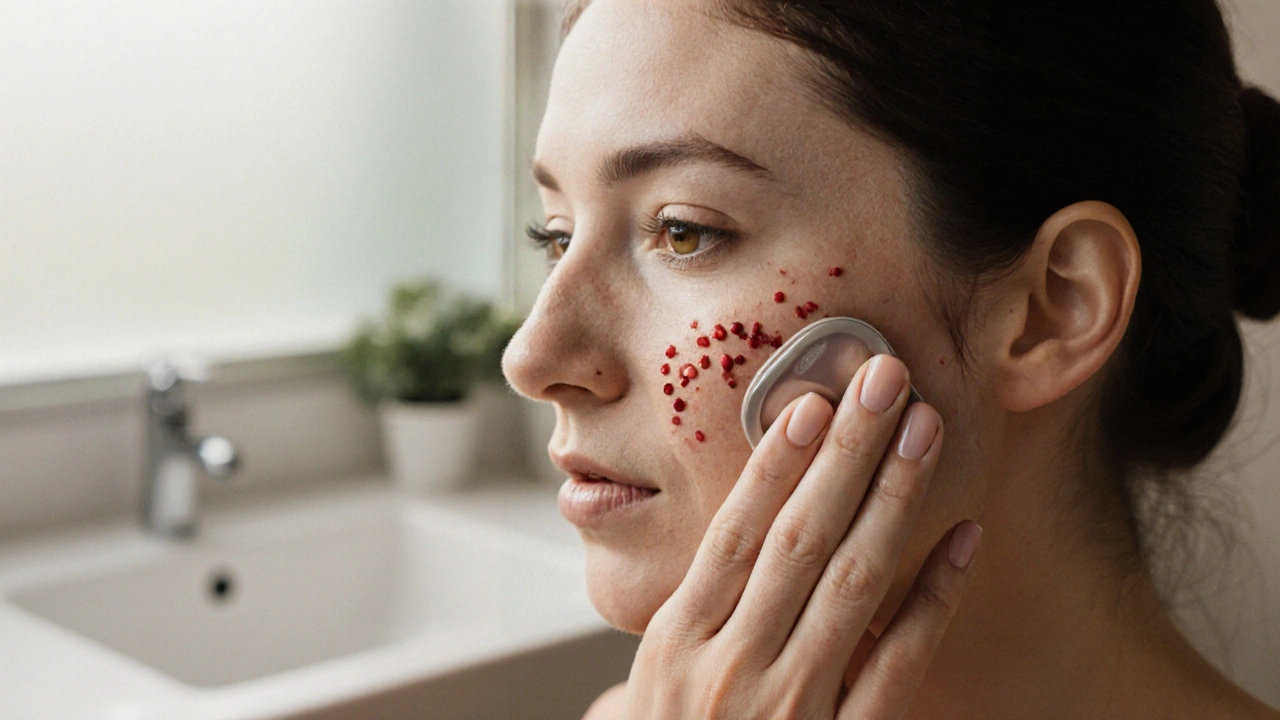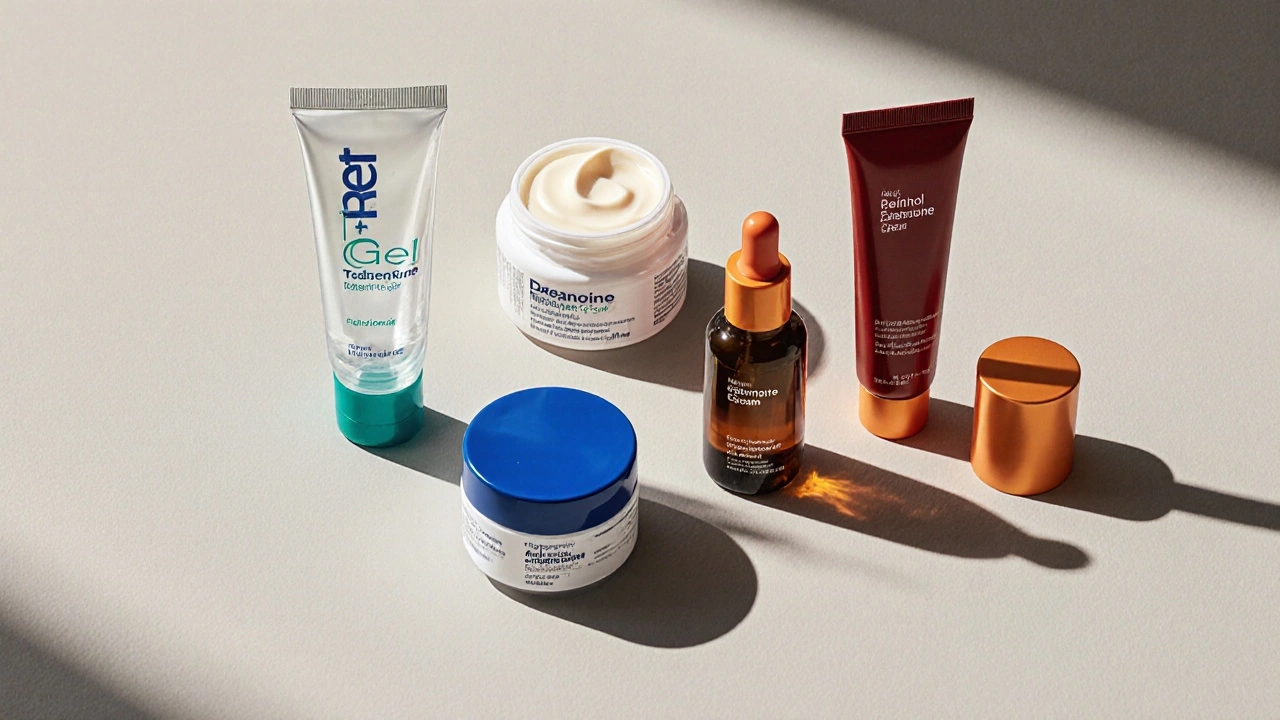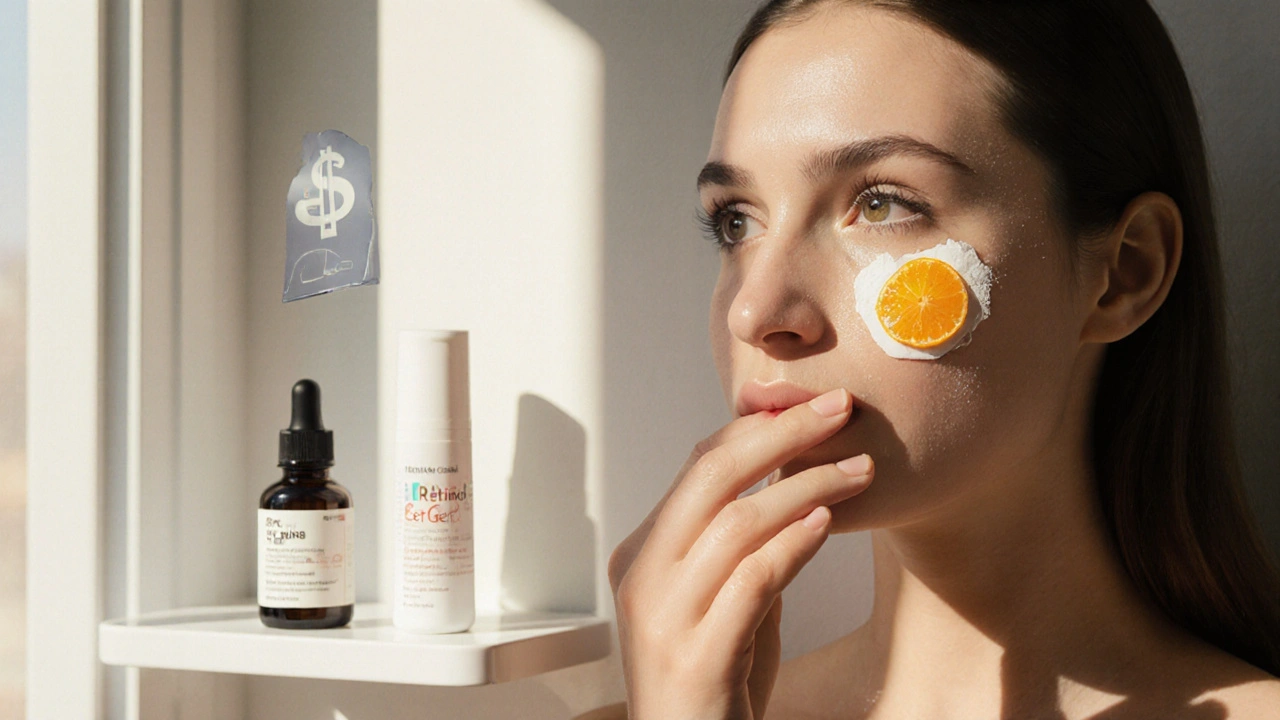
Retinoid Selection Tool
Find Your Perfect Retinoid
Answer these simple questions to get personalized recommendations for the right retinoid product for your skin.
Your Recommendation
Why this product is right for you
How to use
When treating skin issues, A‑Ret Gel is a prescription‑strength tretinoin gel (0.025% or 0.05%) marketed for acne and signs of aging. If you’ve tried it or are thinking about buying it, you probably wonder how it stacks up against other retinoids you can get over the counter or with a simple script. This guide walks you through the science, the costs, and the everyday realities so you can pick the right option for your skin.
Key Takeaways
- A‑Ret Gel delivers a high‑potency form of tretinoin, ideal for moderate to severe acne and noticeable anti‑aging results.
- Generic tretinoin creams provide similar efficacy at a fraction of the price but often lack the gel’s faster absorption.
- Over‑the‑counter retinol and retinyl‑palmitate are gentler, good for beginners or sensitive skin, but they work slower.
- Adapalene and tazarotene are solid alternatives for acne‑prone skin; they differ mainly in irritation potential and cost.
- Choosing the right retinoid hinges on three factors: your primary skin goal, tolerance level, and budget.
What Exactly Is A‑Ret Gel?
A‑Ret Gel is a brand‑name formulation of tretinoin, the gold‑standard retinoic acid used by dermatologists worldwide. It comes in two strengths-0.025% and 0.05%-packed in a clear, non‑comedogenic gel that spreads easily and dries quickly. Because it’s already in the active acid form, there’s no conversion step required, so you see results faster than with retinol‑based products.
Typical uses include:
- Clearing inflammatory acne lesions.
- Reducing fine lines and uneven texture.
- Fading post‑inflammatory hyperpigmentation (PIH).
Side effects are classic retinoid‑related: dryness, mild peeling, and a temporary worsening of acne (the “purge”). Most users need to start with two applications per week and gradually increase to nightly use.

Top Alternatives to A‑Ret Gel
Below are the most common retinoid options you’ll encounter, each with its own niche.
Generic Tretinoin Cream is a hospital‑compounded or pharmacy‑dispensed version of the same active molecule, usually 0.025%‑0.1% in a cream base. It’s the cheapest way to get true tretinoin but the cream base can feel heavier on oily skin.
Retinol is a vitamin A derivative that the skin must convert to retinoic acid before becoming active. Available in serums and moisturizers, retinol is milder and better suited for beginners or people with very sensitive skin.
Adapalene is a synthetic retinoid (0.1% in most OTC products) that targets comedonal acne with relatively low irritation. It’s sold over the counter in the U.S. under brand names like Differin.
Tazarotene is a third‑generation retinoid (0.05%‑0.1%) often prescribed for psoriasis, severe acne, and marked photodamage. It’s the most potent OTC‑available retinoid, but also the most irritating.
Retinyl Palmitate is an ester of retinol and palmitic acid that acts as a very gentle, pro‑vitamin A source. It’s found in many anti‑aging moisturizers and works slowly, making it a good “maintenance” retinoid after you’ve achieved initial results.
Acne is a skin condition characterized by clogged pores, inflammation, and sometimes scarring. Understanding the type of acne you have (inflammatory vs. non‑inflammatory) helps narrow the right retinoid.
Hyperpigmentation is dark spots or uneven tone caused by excess melanin production after injury or inflammation. Retinoids speed up cell turnover, helping fade these spots over weeks to months.
Side‑by‑Side Comparison
| Product | Active Ingredient | Typical Strength | Prescription? | Primary Use | Onset of Visible Results | Irritation Level | Average Monthly Cost (USD) |
|---|---|---|---|---|---|---|---|
| A‑Ret Gel | Tretinoin | 0.025%‑0.05% | Yes | Acne, anti‑aging | 4‑6 weeks | Medium‑High | $45‑$65 |
| Generic Tretinoin Cream | Tretinoin | 0.025%‑0.1% | Yes (often via compounding) | Acne, anti‑aging | 4‑6 weeks | Medium‑High | $15‑$30 |
| Retinol Serum | Retinol | 0.3%‑1% | No | Anti‑aging, mild acne | 8‑12 weeks | Low‑Medium | $25‑$45 |
| Adapalene (OTC) | Adapalene | 0.1% | No | Comedonal acne | 6‑8 weeks | Low‑Medium | $20‑$35 |
| Tazarotene Cream | Tazarotene | 0.05%‑0.1% | Yes (some brands OTC in select markets) | Severe acne, photodamage | 3‑5 weeks | High | $70‑$120 |
| Retinyl Palmitate Cream | Retinyl Palmitate | 0.5%‑2% | No | Maintenance, very mild anti‑aging | 12‑16 weeks | Very Low | $15‑$30 |
How to Choose the Right Retinoid for Your Skin
- Define your primary goal. If clearing moderate to severe acne is the top priority, a true tretinoin product (A‑Ret Gel or generic cream) is usually best. For fine lines and subtle tone improvement, retinol or retinyl palmitate can work well.
- Assess your tolerance. Sensitive skin types often benefit from starting with adapalene or a low‑strength retinol serum. If you’ve used retinoids before without major irritation, you can move up to tretinoin or tazarotene.
- Check your budget and prescription access. A‑Ret Gel offers consistency but costs more. Generic tretinoin compounds give the same results for less money if you have a doctor’s script. Over‑the‑counter options avoid the prescription hurdle entirely.
- Consider formulation preferences. Gels dry faster and feel lighter-great for oily or combination skin. Creams are richer, suitable for dry or mature skin. Serums blend easily with moisturizers for a multi‑step routine.
- Plan for a transition period. When switching from a strong retinoid to a milder one, taper the frequency to avoid a sudden drop in efficacy. Conversely, when stepping up, introduce the new product every third night for two weeks before moving to nightly use.

Practical Tips for Using Any Retinoid Safely
- Start slow. Apply a pea‑size amount to clean, dry skin in the evening. Begin with 2‑3 times per week and increase as tolerated.
- Pair with sunscreen. Retinoids thin the outer skin layer, making you more photosensitive. Use SPF 30+ daily, even on cloudy days.
- Moisturize strategically. Wait 15‑20 minutes after retinoid application, then lock in hydration with a ceramide‑rich moisturizer. This reduces peeling without compromising efficacy.
- Avoid mixing harsh actives. Skip benzoyl peroxide, high‑strength AHAs, or physical scrubs on the same night to prevent excessive irritation.
- Watch for the purge. An initial spike in breakouts is normal; if it lasts beyond four weeks, reassess concentration or frequency.
Frequently Asked Questions
Is A‑Ret Gel stronger than regular tretinoin cream?
Both contain the same active molecule, but the gel base allows quicker absorption and often feels lighter on the skin. The actual strength depends on the percentage (0.025% or 0.05%). In practice, many users find the gel delivers results a bit faster than a thick cream.
Can I use retinol while on A‑Ret Gel?
It’s not recommended. Both are vitaminA derivatives, and layering them can cause severe irritation. If you want the benefits of both, alternate nights-retinol on the three nights you skip A‑Ret Gel.
How long does it take to see acne improvement with A‑Ret Gel?
Most dermatologists see noticeable lesion reduction within 4‑6weeks, though full clearance can take 3‑4months depending on severity.
Is adapalene a good starter for sensitive skin?
Yes. Adapalene’s chemical structure makes it less irritating than tretinoin while still unclogging pores. Start with twice a week and build up.
Do I need a prescription for tazarotene?
In most countries tazarotene is prescription‑only because of its potency. Some regions now sell a 0.05% cream over the counter, but it’s best to check local regulations.
Next Steps
1. Write down your main skin concern (acne, wrinkles, dark spots). 2. Match that concern to the product column in the comparison table. 3. If budget is a limiting factor, prioritize generic tretinoin or retinol. 4. Schedule a quick consult with a dermatologist to confirm the right strength and to get the prescription if you choose A‑Ret Gel or a generic cream. 5. Start with the low‑frequency schedule outlined above and track progress for six weeks.
By understanding the strengths and trade‑offs of each retinoid, you can avoid wasted money and unnecessary irritation. Whether you stick with A‑Ret Gel or switch to a gentler alternative, consistency and sun protection are the true keys to smoother, clearer skin.

lee charlie
October 13, 2025 AT 21:52Start slow and your skin will thank you.
KIRAN nadarla
October 14, 2025 AT 11:45It appears the original guide conflates tretinoin and retinol, which are chemically distinct. Tretinoin is the active acid form; retinol requires conversion within the epidermis. This distinction matters because efficacy and irritation profiles differ markedly. Moreover, the cost comparison should reference the exact concentration rather than a broad range. Clarifying these points would improve the utility of the article.
Sonia Michelle
October 15, 2025 AT 01:38Choosing the right retinoid is a bit like picking a workout routine for your skin.
You have to consider what you want to achieve, whether it's clearing breakouts, smoothing fine lines, or fading dark spots.
Tretinoin, the active form of vitamin A, delivers results fastest but also brings the highest irritation potential.
For newcomers with sensitive skin, starting with a low‑strength adapalene or a gentle retinol serum often yields better long‑term compliance.
The gel formulation, such as A‑Ret Gel, feels lighter on oily or combination skin and can be less occlusive than a cream.
Cream bases, while richer, are advantageous for dry or mature skin because they lock in moisture.
Prescription strength tretinoin, whether in gel or cream, typically shows visible improvement in 4 to 6 weeks when used consistently.
Over‑the‑counter retinol generally requires 8 to 12 weeks to produce similar changes, owing to the conversion step.
Tazarotene is the most potent OTC‑available retinoid, but its high irritancy means it should be introduced slowly, perhaps twice a week.
Budget is another practical factor; generic tretinoin compounding can shave off 60 % of the cost compared with brand‑name gels.
Sun protection cannot be overstated-any retinoid increases photosensitivity, so a broad‑spectrum SPF 30+ is mandatory.
Moisturizing after application, ideally after a 15‑minute wait, helps mitigate peeling without neutralizing the active.
Avoiding simultaneous use of strong acids like glycolic or salicylic on the same night reduces the risk of over‑exfoliation.
If you notice a severe purge lasting longer than four weeks, consider dialing down the frequency or stepping down the concentration.
Ultimately, consistency, patience, and a tailored routine are the three pillars of success with any retinoid.
Neil Collette
October 15, 2025 AT 15:32Sure, because a 15‑sentence dissertation automatically guarantees flawless skin, right? In reality, most people simply need to apply the product correctly and stay out of the sun-not write a novel. Your “pillars of success” sound more like a marketing brochure than practical advice. Also, the claim that generic compounding saves 60 % ignores pharmacy markup variability. Let’s keep the hype in check and focus on the basics.
Adele Joablife
October 16, 2025 AT 05:25While the guide covers most options, it glosses over the fact that some OTC retinol serums contain destabilizing ingredients that can degrade the active. Checking the packaging for antioxidants like vitamin E can make a noticeable difference.
Jeremy Olson
October 16, 2025 AT 19:18Indeed, the inclusion of stabilizers such as vitamin E or ferulic acid is a crucial factor for product efficacy. Consumers should scrutinize the ingredient list for these components to ensure the retinol remains potent throughout its shelf life.
Ada Lusardi
October 17, 2025 AT 09:12Got the gel? 😊
Pam Mickelson
October 17, 2025 AT 23:05The article correctly distinguishes between tretinoin and retinol, yet it could benefit from a clearer explanation of the conversion process. A brief schematic would aid readers unfamiliar with the biochemistry.
Joe V
October 18, 2025 AT 12:58Oh, because a schematic will magically turn everyone into a dermatologist. Some readers just want to know if they should buy the gel or stick with a serum, not study a textbook.
Brenda Hampton
October 19, 2025 AT 02:52I appreciate the detailed comparison table; it makes spotting cost and irritation differences straightforward. However, it would be useful to see a column for recommended usage frequency per product. That way, newcomers can better gauge how to integrate the retinoid into their routine without guessing.
Lara A.
October 19, 2025 AT 16:45Wait-why is the pharma industry pushing A‑Ret Gel soooo hard??? They want us all to be dependent on pricey prescriptions!!! It's a classic control tactic!!!
Gayatri Potdar
October 20, 2025 AT 06:38i think thse retinoids r just a big lie from big pharma they dont want u to know about natural herbs that work better!!!
Marcella Kennedy
October 20, 2025 AT 20:32First of all, thank you for sharing your perspective; it’s important that we feel safe expressing concerns.
The scientific community has conducted extensive trials on retinoids, and the data consistently show that tretinoin, when used as directed, can improve acne and signs of aging more effectively than many “natural” alternatives.
That said, there are herbal extracts such as bakuchiol that some users find helpful, and they can be incorporated alongside retinoids if tolerated.
The key is to evaluate each ingredient on its own merits rather than dismiss everything from a single source.
If cost is a barrier, compounding pharmacies often offer generic tretinoin at a fraction of the brand price, which addresses the affordability concern you raised.
Moreover, proper usage-including gradual introduction, moisturization, and diligent sunscreen-greatly reduces the risk of irritation, a common fear among newcomers.
Should you decide to explore non‑prescription options, start with a low‑strength retinol and monitor your skin’s response before moving up.
Remember that every individual’s skin chemistry is unique, so a trial-and-error approach, guided by reputable information, is the safest path forward.
Ultimately, we all benefit when we share experiences, question claims, and support each other in the quest for healthier skin.
Jamie Hogan
October 21, 2025 AT 10:25One must recognise that the discourse surrounding retinoids often suffers from oversimplification
Ram Dwivedi
October 22, 2025 AT 00:18Absolutely-simplifying isn’t always bad; clear language helps readers make informed choices 😊